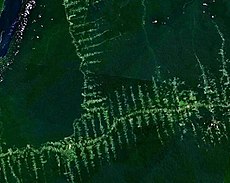| Revision as of 17:27, 9 September 2011 editSuchthekaitlin (talk | contribs)18 edits →Public input and awareness: Added info on international awareness campaign← Previous edit | Revision as of 17:52, 9 September 2011 edit undoMrOllie (talk | contribs)Extended confirmed users, Pending changes reviewers, Rollbackers236,928 edits Reverted 1 edit by Suchthekaitlin (talk): Rv refspam. (TW)Next edit → | ||
| Line 4: | Line 4: | ||
| ==Public input and awareness== | ==Public input and awareness== | ||
| There has been an increased public awareness of natural resource policy, including forest management. Public concern regarding forest management may have shifted from the extraction of timber to the preservation of additional forest ], including ] and ], protecting ], ] management, and ]. Increased environmental awareness may contribute to an increased public mistrust of forest management professionals.<ref>{{cite journal |quotes= |last=Shindler |first=Bruce |authorlink= |coauthors=Lori A. Cramer |date= |year=1999 |month=January |title=Shifting Public Values for Forest Management: Making Sense of Wicked Problems |journal=Western Journal of Applied Forestry |volume=14 |issue=1 |pages=28–34 |publisher=Society of American Foresters |location= |issn=0885-6095 |pmid= |pmc= |doi= |bibcode= |oclc= |id= |url=http://www.fs.fed.us/eco/eco-watch/wickedpr.html |language= |accessdate=2008-08-25 |laysummary= |laysource= |laydate= |quote= }}</ref> | There has been an increased public awareness of natural resource policy, including forest management. Public concern regarding forest management may have shifted from the extraction of timber to the preservation of additional forest ], including ] and ], protecting ], ] management, and ]. Increased environmental awareness may contribute to an increased public mistrust of forest management professionals.<ref>{{cite journal |quotes= |last=Shindler |first=Bruce |authorlink= |coauthors=Lori A. Cramer |date= |year=1999 |month=January |title=Shifting Public Values for Forest Management: Making Sense of Wicked Problems |journal=Western Journal of Applied Forestry |volume=14 |issue=1 |pages=28–34 |publisher=Society of American Foresters |location= |issn=0885-6095 |pmid= |pmc= |doi= |bibcode= |oclc= |id= |url=http://www.fs.fed.us/eco/eco-watch/wickedpr.html |language= |accessdate=2008-08-25 |laysummary= |laysource= |laydate= |quote= }}</ref> | ||
| To increase public awareness, the United Nations General Assembly declared 2011 the ] as a global platform to celebrate what individuals are already doing to increase sustainability, and to spread education and awareness worldwide.<ref>{{cite web|title=About the Year of Forests|url=http://www.celebrateforests.com/about-year-forests|publisher=National Association of State Foresters|accessdate=9 September 2011}}</ref> | |||
| Many tools like ] modelling have been developed to improve forest inventory and management planning.<ref></ref> | Many tools like ] modelling have been developed to improve forest inventory and management planning.<ref></ref> | ||
Revision as of 17:52, 9 September 2011
Forest management is the branch of forestry concerned with the overall administrative, economic, legal, and social aspects and with the essentially scientific and technical aspects, especially silviculture, protection, and forest regulation. This includes management for aesthetics, fish, recreation, urban values, water, wilderness, wildlife, wood products, forest genetic resources and other forest resource values. Management can be based on conservation, economics, or a mixture of the two. Techniques include timber extraction, planting and replanting of various species, cutting roads and pathways through forests, and preventing fire.
Public input and awareness
There has been an increased public awareness of natural resource policy, including forest management. Public concern regarding forest management may have shifted from the extraction of timber to the preservation of additional forest resources, including wildlife and old growth forest, protecting biodiversity, watershed management, and recreation. Increased environmental awareness may contribute to an increased public mistrust of forest management professionals.
Many tools like GIS modelling have been developed to improve forest inventory and management planning.
Wildlife considerations
The abundance and diversity of birds, mammals, amphibians and other wildlife are affected by strategies and types of forest management.
See also
- Biodiversity
- Community forestry
- Certified wood
- Conservation biology
- Environmental protection
- Even aged timber management
- Forest farming
- Forest informatics
- Growth and yield modelling
- Habitat conservation
- Healthy Forests Initiative
- Natural environment
- Natural landscape
- Nature
- Outline of forestry
- Overexploitation
- Renewable resource
- Sustainability
- Sustainable development
- Sustainable forest management
- Sustainable forestry
References

- "Glossary of Forestry Terms in British Columbia" (pdf). Ministry of Forests and Range (Canada). 2008-03. Retrieved 2009-04-06.
{{cite web}}: Check date values in:|date=(help) - Shindler, Bruce (1999). "Shifting Public Values for Forest Management: Making Sense of Wicked Problems". Western Journal of Applied Forestry. 14 (1). Society of American Foresters: 28–34. ISSN 0885-6095. Retrieved 2008-08-25.
{{cite journal}}: Cite has empty unknown parameters:|laydate=,|laysource=,|laysummary=, and|quotes=(help); Unknown parameter|coauthors=ignored (|author=suggested) (help); Unknown parameter|month=ignored (help) - Mozgeris, G. (2008) “The continuous field view of representing forest geographically: from cartographic representation towards improved management planning”. S.A.P.I.EN.S. 1 (2)
- * Philip Joseph Burton. 2003. Towards sustainable management of the boreal forest 1039 pages
This article about forestry is a stub. You can help Misplaced Pages by expanding it. |
This sustainability-related article is a stub. You can help Misplaced Pages by expanding it. |